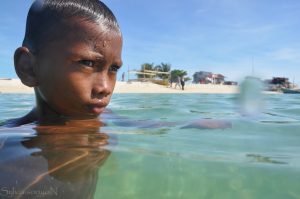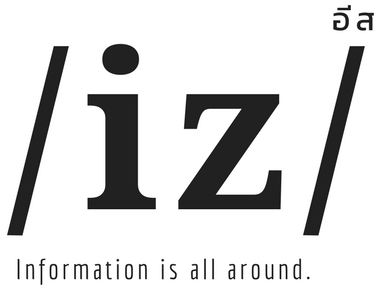I had an opportunity to visit a Moklen village, an ethic minority group, in Phang-nga province earlier this year to work with Department of Linguistics to develop approaches to preserve the language. I was wondering how we, as an outsider, could help this community.
Moklen is used to be one of the “sea gypsies” in Thailand. The language used among the Moklen is now under threat for extinction since it could not pass on to the next generation, just like many other endangered languages in the world. An estimate of 6,000 Moklen speakers – right around the median number of speakers for all 6,900+ languages of the world, is reported on the UNESCO Atlas of the World’s Languages in Danger. Leaders of the group are worried that the declining use of Moklen would not only affect the identity of the group, but also weaken the well-being of people in the community.
Since the great Tsunami disaster in 2004, the conflicts on land use among ethnic minorities, capitalists, and the government agencies has increasingly emerged and were widely documented by local and international news media. Some families have lost their homes and working land. Without any official records, it is almost impossible to claim their properties. In addition to legal procedures, the group realizes that cultural identity is one of the most crucial aspects to prove their long-time existence and their parts in Thai history and culture. Saving the language would help them to claim their public rights and eventually save their community.

Alarmingly, around 60% to 90% of the world languages may be at risk of extinction over the next 100 years. Asia-Pacific region alone contains approximately 32.8 percent of languages spoken in the world. 820 languages are found in Papua New Guinea, 742 in Indonesia, 427 in India, 275 in Australia, 241 in China, 180 in the Philippines, 147 in Malaysia, 125 in Nepal, and 113 in Myanmar (Romaine, 2007). However, about 79.5 percent of the world’s population speaks 75 languages. According to the UNESCO’s atlas, more than 2,400 languages has 10,000 speakers or less.
Perhaps, not all language may need to be preserved. How shall we select languages to be preserved? How do we measure endangerment or vulnerability of languages? If all languages should be preserved and resources are restricted, which criteria would be in place to prioritize for language preservation?
Even we know which languages to be preserved, what can we do to preserve endangered languages?
Suzanne Romaine (2007), a historical linguistic and sociolinguistic Professor at Oxford University, characterizes 3 current approaches to preserve endangered languages as follows.
First, certain groups encourage the use of languages outside their communities, particularly in the domains occupied by majority languages, such as government and school. Aiming to attract new users from outside, this approach may not increase the inter-generation adoption of languages.
The second approach focuses on integrating the languages in formal learning programs. Perhaps the most logical approach, nevertheless, this immersion approach requires substantial supports from established social organizations and needs a large group of active community members. This would be a big challenge for languages that has small numbers of speakers.
Documentation through, for instance, developing orthography, publishing a dictionary, and examining grammars, is the last approach for preserving endangered languages and usually deployed with the immersion approach. Although this seems to be the most practical approach, documentation relies heavily on the durability of physical and technological medium. Unfortunately, none of the medium currently available are long lasting – given that the digital medium are apparently more fragile than physical ones.
While adopting all three approaches are possible, some critical linguistic scholars argue that there has not been a successful case of language preservation. Instead, Romaine pointed out that the preservation should consider the entire ecology of language.
“Languages can only exist where there is a community to speak and transmit them. A community of people can exist only where there is a viable environment for them to live in and a means of making a living. Where communities cannot thrive, their languages are in danger.”
For Moklen, in the present days, even the community spirit still exists particularly among the leaders, the way of life of people in the community has changed drastically. The number of “sea gypsies” is declining continuously. An increasing number of inhabitants are seeking jobs at resorts, factories, or stores in the city nearby, due to hardship in fishery. Certain people move out of the community to seek a fortune. Even though Moklen language are taught in primary and secondary schools near the community, the teachers are not fluent in the language while the local people do not qualify to teach in formal education systems. They now communicate with outsiders more and more. Thus, less people speak the language in their daily activities. This is one of the most challenging ecology systems to sustain the use of their endangered language. Apparently this would probably be the case for most endangered languages too.
Considering that spoken languages are more in danger to be extinct than those that have written medium, spoken language can be considered intangible cultural heritage. Recording endangered language by any means, Romaine argues, would be like constructing a museum building. It does not help the next-generation adopts the language. Thus, the problems discussed here are (and should be) beyond linguists’ concern. Preserving language diversity requires collaboration from all aspects of personal life, community, and administration.
Seemingly, the lessons learned from language preservation can be applied to any preservation of information objects. As conservators and preservers, we do not preserve only objects. More importantly, we concern about the knowledge, wisdom, believe, and thought that are recorded in the objects. To make a preservation program successful, the entire ecology of information lifecycle should also be taken into account. As an outsider like most of us who are reading to the end of this article, opening our heart to diverse cultures and lifestyles would be just the right beginning.
Further readings
- Moseley, C. (ed.). (2010). Atlas of the World’s Languages in Danger. 3rd ed. Paris: UNESCO Publishing. Retrieved from http://www.unesco.org/culture/en/endangeredlanguages/atlas
- Romaine, S. (2007). Preserving endangered languages. Language and Linguistics Compass, 1(1-2), 115-132. doi: 10.1111/j.1749-818X.2007.00004.x


One thought on “Sustaining community through language preservation”